Unlock your game’s true potential with an efficient grasp on your paddle. Proper gripping of the pickleball paddle sets the foundation for good play.
Explore the science and art of achieving the perfect grip in this comprehensive guide on how to hold a pickleball paddle.
Expert or beginner, there’s always room to advance and refine your skills.
Tune in for practical tips and tricks, designed to improve your accuracy, control and overall pickleball game performance.
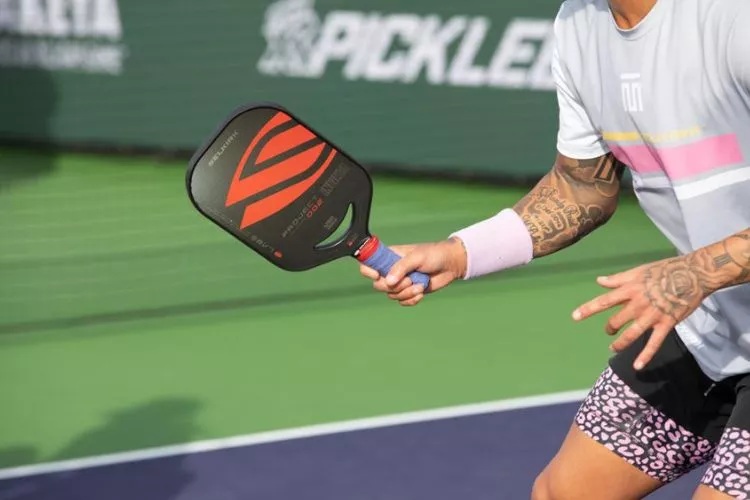
Let’s embark on this journey of mastering the pickleball paddle grip together!
How to Hold a Pickleball Paddle: A Detailed Guide
Mastering how to correctly grip a pickleball paddle can drastically improve your game skills. A strong foundation forms the basis of your pickleball prowess.
This guide provides an in-depth, easy-to-follow approach to perfect your paddle grip.
Understand The Basics
Before diving in, familiarize yourself with your paddle. Notice the handle – the part you’ll grip – and the face of the paddle, intended to make contact with the ball.
Make sure you’re comfortable with the weight and size of the pickleball paddle you’re using. This will prevent discomfort or injury during play.
The Eastern Grip
- Positioning: A dominant grip style in pickleball is the ‘Eastern Grip’. Hold your paddle face flat on the ground. Pick it up as if you were shaking someone’s hand, ensuring your palm’s base remains perpendicular to the paddle’s handle.
- Fingers: Wrap your fingers around the handle. Let the underside of the handle rest on your index finger’s knuckle. Your thumb should be pressed against the back of the handle. Be sure that your grip is firm but not tight.
- Checking: To check if the grip is right, your paddle face should be perpendicular to the ground when you stretch your arm straight out in front of you.
The Continental Grip
The ‘Continental Grip’ is another popular grip choice among players.
- Positioning: Imagine you’re holding an axe or hammer. Here, you position your knuckle and the base of your thumb on the second bevel of your paddle’s grip.
- Fingers: Follow the same finger technique as the Eastern Grip.
- Checking: The paddle face here should be slightly closed (facing downward) when you stretch your arm straight out in front of you.
Fine-Tuning Your Grip
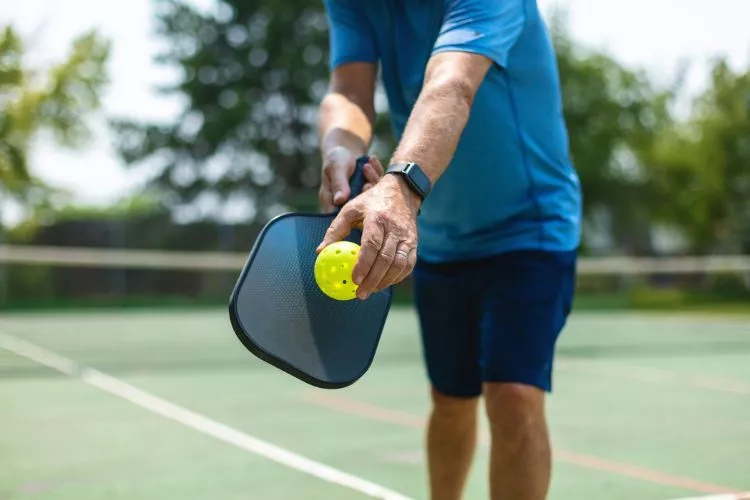
Handshake, Not Death Grip
- Pressure: Pay attention to the pressure you exert. You should maintain a firm but relaxed grip, similar to a friendly handshake. A gentle grip allows for wrist movement and reduces the risk of injuries.
- Muscle Tension: Take note of your forearm and shoulder muscles, and ensure they stay loose during play. Over-gripping can lead to muscle fatigue and cramped strokes, affecting your overall performance.
Paddle Control
- Finger Positioning: The optimal grip transfers the paddle’s control to your fingers while supporting it with your palm. Your index finger should act as a guide, providing direction for your shots.
- Quick Adjustments: Proper paddle control allows for swift adjustments to different types of shots, whether you’re hitting a powerful drive or performing a delicate drop shot.
Switch Up
- Versatility: Be open to experimenting with and switching between the Eastern and Continental grips as required during matches. A grip change may provide increased control and power for specific shots.
- Adaptability: Adapt your grip depending on your position on the court. For example, you may want to switch to the Continental grip when playing at the net for more precise shots.
Perfecting with Practice
Consistency
- Repetition: Repeating proper grip techniques will help strengthen muscle memory, leading to more consistent on-court performance.
- Posture Awareness: Good posture is essential when learning to grip your paddle correctly. Stay aware of your posture while playing to ensure a better connection between your body and the paddle.
Drills and Tips
- Wall Practice: Utilize a wall to practice your paddle grip and ball contact. Hitting the ball against the wall will help you adapt your grip to different shots and angles, enhancing your control.
- Grip Strengthening: Exercises that focus on grip strength, such as squeezing a stress ball or using a grip strengthening tool, can help improve control and minimize fatigue during gameplay.
Continuous Learning
- Feedback: Seek guidance from experienced players or coaches to perfect your grip. Pay attention to their tips and recommendations to boost your performance.
- Research: Stay up-to-date on grip techniques by watching professional pickleball players and participating in clinics or workshops.
With the right mindset, patience, and persistence, you’ll be on your way to perfecting your pickleball paddle grip and enhancing your overall game.
Pickleball Grip Tape
Pickleball grip tape is an essential accessory for players, as it significantly improves their paddle grip and overall performance during matches. Grip tape offers a wide range of benefits:
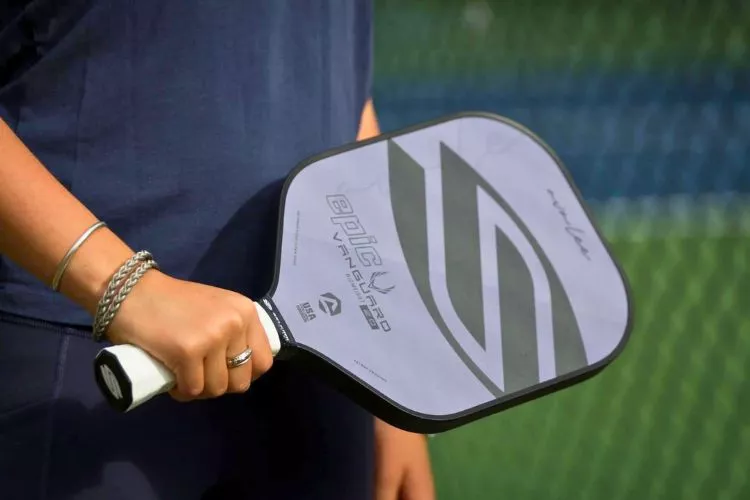
- Comfort: Adding grip tape to your paddle increases the overall comfort of your grip, ensuring smoother gameplay.
- Moisture Absorption: The tape materials (like cotton, PU, and synthetic blends) absorb sweat and moisture from your hands, providing a secure grip as you play.
- Tackiness: Grip tape often has a tacky feel, ensuring a non-slip hold on your paddle, and allowing for better control and shot precision.
- Customization: Some grip tapes come in various thicknesses, textures, patterns, and colors, allowing you to personalize your paddle to your preference.
- Shock Absorption: A good quality grip tape can also help absorb vibrations from ball impacts, reducing stress on your hand and arm muscles.
To apply grip tape, start at the bottom of your paddle’s handle, and gradually wrap it around the circumference, working your way up toward the neck. Ensure it’s wrapped tightly and evenly to avoid any creases or lumps.
Pickleball Grip: Index Finger
Your index finger’s positioning plays a crucial role in providing adequate control and power when gripping your pickleball paddle. Several grips incorporate the index finger as a crucial part of their technique:
- Eastern Grip: With this grip, the underside of the paddle’s handle should rest on your index finger’s knuckle, allowing for better control during gameplay.
- Continental Grip: Similar to the Eastern Grip, the Continental Grip keeps your knuckle and the base of your thumb on the second bevel of the paddle’s grip.
Your index finger (referred to as the “trigger finger” in pickleball) is essential for the following reasons:
- Direction and Control: The index finger works as a guide for your swing, intuitively directing the angle and placement of your shots.
- Stability: Proper placement of your index finger adds stability to your grip and paddle, giving you firmer control over each shot.
- Balance: Your index finger’s positioning can help balance the weight of the paddle, ensuring that you can comfortably hold and maneuver the paddle during play.
To maximize the effectiveness of your grip, it’s essential to keep a relaxed and flexible hold on your paddle, allowing ample movement of your fingers and wrist during play.
Through practice and experience, you’ll be able to fine-tune your grip and index finger placement to achieve maximum control, comfort, and skill during your pickleball games.
How do you hit a sweet spot on a pickleball paddle?
Hitting the sweet spot on a pickleball paddle is crucial for achieving power and control in your shots. Let’s delve into some specific recommendations on how to achieve this consistently.
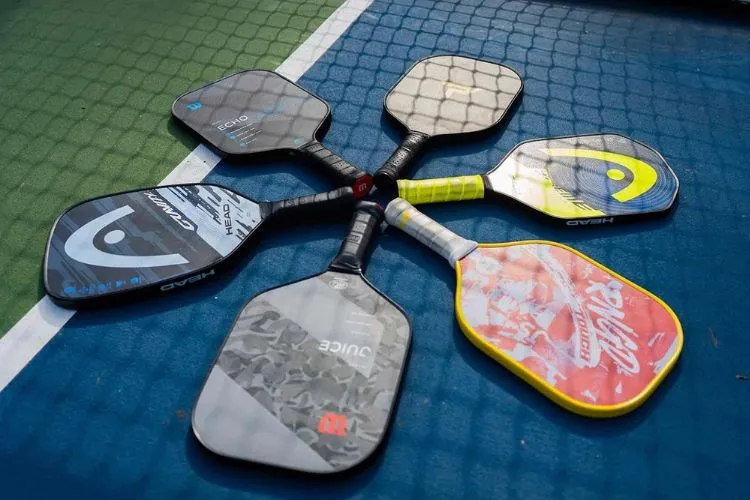
Understand the Sweet Spot
The ‘sweet spot’ refers to the central part of the paddle’s face, where the construction is the most robust. When you hit the ball with this portion, your shots are better controlled and are often more potent.
Footwork and Positioning
Excellent footwork is critical in ensuring you consistently hit the sweet spot.
- Anticipation: Study your opponent’s movements to anticipate their shots, enabling you to prepare and position for the return.
- Adjustment steps: Make small adjustment steps to align yourself with the incoming ball.
- Proper stance: Stand properly. Your knees should be slightly bent and shoulders squared with the net.
Work on Your Swing
Good swings ensure you contact the ball with the sweet spot consistently.
- Controlled Backswing: A controlled backswing allows for accurate tracking of the ball with your paddle. It makes it easier to connect the ball with your paddle’s sweet spot.
- Forward Swing: Swing your paddle forward, focusing on hitting the ball with the paddle’s center. Practicing a compact swing with quick wrist motion helps maintain control over the shot.
Practicing Shot Accuracy
Besides positioning and swing, you also need to work on shot accuracy.
- Ball Contact: Throughout your practice sessions, aim to contact the ball with the sweet spot of the paddle as often as possible.
- Watch the ball: Keep your eyes on the ball until contact to improve your accuracy.
- Shot Placement: Visualize your shot’s placement before striking and aim for consistency in hitting the targeted spot.
Drill for Sweet Spot Accuracy
Set up consistent drills to practice hitting the sweet spot. This could involve rallying against a wall or with a partner with the aim to connect the ball with the center of the paddle on each return.
Equipment
Consider the paddle you are using. Larger-faced paddles will have a larger sweet spot, providing more room for error.
Remember, consistency is the key. With regular practice, you will develop a keen sense for hitting the sweet spot on your pickleball paddle, improving the accuracy, control and power of your game.
How to hold pickleball paddle when serving?
To effectively serve in pickleball, it’s crucial that you adopt the correct grip on your paddle.
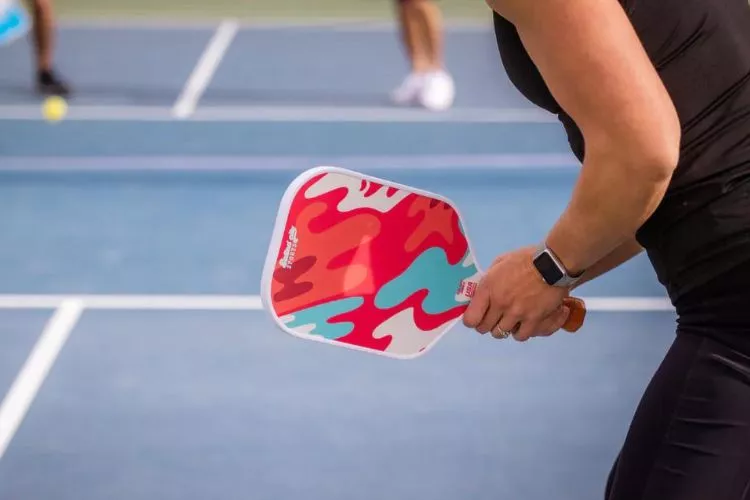
One of the most common grips used in pickleball for serving is the Continental grip, where “the base knuckle of your index finger rests on the top bevel of the paddle handle”.
Another important aspect of your grip is your grip pressure. According to Pickle Drive, it’s generally recommended to use a relaxed or loose pickleball grip when serving the ball for optimal results, as “this allows for a more fluid swing motion and enables you to generate paddle speed.
Regarding the act of serving, aside from the correct grip, efficient weight transfer and a well-timed step forward are crucial for a powerful and accurate serve.
Holding your paddle like a fly swatter, akin to a western grip, can also be a beneficial approach.
In the end, patience and practice are key to finding the grip style that gives you the most control and comfort.
Always remember that a proper grip will significantly affect how you hit the pickleball and what kind of shots you hit on the pickleball court.
Conclusion:
Mastering the art of holding a pickleball paddle is pivotal to improving your game and ensuring an excellent on-court performance.
From choosing between the Continental and Eastern grip styles, adapting your hand position for different plays, to understanding the crucial role of the index finger, each aspect plays a significant role in enhancing your pickleball control and precision.
Remember, a firm yet relaxed grip is key, and regular practice is essential to build muscle memory and comfortable hand-eye coordination.
So, take note of these crucial tips, apply them to your game, and experience the gratifying improvements!

Pickleball’s more than a game to me—it’s a passion. I write, sharing its highs and lows, the thrills and the lessons. Some tales might draw you to the court, while others give a hint of the game’s magic. So, curious about my journey? Ready to dive deep into the world of pickleball with me? Let’s go.
